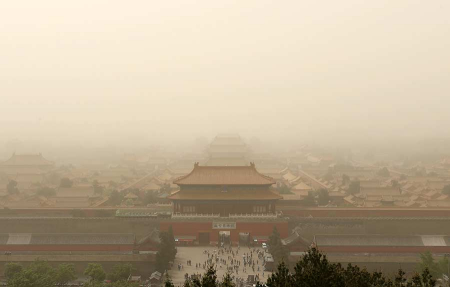
A heavy sandstorm engulfs Beijing, with the air pollution reaching the hazardous level. (Photo/China Daily)
Beijing on Thursday released the year's first blue alert for sandstorms, as sand and dust swept over the capital, obscuring visibility and seriously polluting the air.
The sandstorm forced the cancellation of 15 flights and delayed 40 others, the Beijing Times reported.
The Beijing Municipal Environmental Monitoring Center (BMEMC) said sand and dust swept the capital at 4:00 a.m. and most monitoring stations in the city showed readings of PM 10 - larger particles in the air harmful to health - skyrocketing to more than 1,000 micrograms per cubic meter.
Government data also showed that the average intensity of PM 2.5 in some areas in Beijing rising to more than 500 micrograms per cubic meter.
BMEMC official Cheng Nianliang told the Legal Daily newspaper that the rise in the density of PM 10 was related to the high temperature and dry air, while the rise of PM 2.5 was mainly caused by dust from other regions.
Visibility was reduced to as low as one kilometer in many parts of Beijing and is expected to fall further. Many pedestrians in downtown Beijing were seen wearing protective masks.
The National Meteorological Center (NMC) said sand and dust are expected to plague most of China's northern provinces, including the Xinjiang Uyghur Autonomous Region, Shaanxi Province and Ningxia Hui Autonomous Region, on Thursday and Friday.
NMC said that the severe weather affected more than 10 provincial-level regions and covered an area of 1.63 million square kilometers. Meanwhile, a strong cold front will sweep north China including areas in Inner Mongolia and northeast regions.
Experts said that the sandstorms originated in Mongolia, home to the Gobi desert.
Sand and dust weather occurred 22 times as well as 11 sandstorms in 2001. The number has been declining since then, with less than twice a year in 2011, 2014, 2015 and 2016.
Data from the Beijing Meteorological Service showed that during the 1950s, the worst period, an average of 26 days experienced sand and dust weather during spring. However, the occurrence declined from the 1960s to the 1980s. In the 1990s, the average number of days was five. The service said Beijing is experiencing a fewer number of days of sand and dust weather.
NMC engineer Zhang Bihui said that the improvement in the past 10 years can be attributed to human controls and climate change.
With global warming, strong winds have been declining, which has led to the decline in sand and dust weather, Zhang said.
China has invested in northwest-north-northeast China networks of shelterbelts.
A total of 87.79 billion yuan ($13.72 billion) has been earmarked to help control the sources of sandstorms that affect Beijing and neighboring Tianjin from 2013 to 2022.


















































